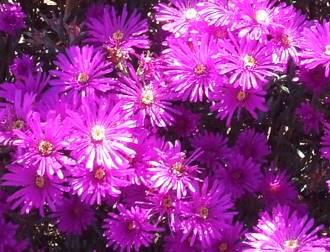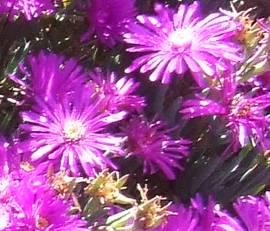Lampranthus hoerleinianus
Lampranthus hoerleinianus (Dinter) Friedrich
Family: Aizoaceae
Common names: purple vygie
Introduction
Lampranthus hoerleinianus, a tall mesemb with showy purple flowers, is found in northern Namaqualand, the Richtersveld and southern Namibia.

Description
Description
Lampranthus hoerleinianus is an erect, shallow-rooted succulent shrublet with a fibrous root system. In its natural habitat it may attain a height of 1 m and can live as long as 10 years; in cultivation it may reach a height of only 75 cm and live as long as six years. The leaves are ascending, semi-cylindrical, measuring 30 x 4 mm. The flowers are 40-45 mm in diameter. Flower colour is variable, ranging from bright purple to mauve, pink and occasionally white. The fruit capsules open star-like with 5 valves when wetted. They contain a number of brown to black seeds 1-2 mm long.

Conservation Status
Status
The purple vygie is not considered to be endangered and has not been accorded red data status.
Distribution and habitat
Distribution description
Lampranthus hoerleinianus grows in the winter rainfall region of Namaqualand, Richtersveld and southern Namibia. It occurs in rocky and semi rocky habitats.
Derivation of name and historical aspects
History
The genus Lampranthus is derived from the Greek lampros which means bright or shining, and anthemum which means flower. The specific epithet hoerleinianus honours a Mr Hörlein, Director of Consolidated Diamond Mines (CDM) in Lüderitzbucht, who assisted Dinter with his botanical expedition to the southern Namib in 1922.
Ecology
Ecology
Lampranthus hoerleinianus flowers from August to September in its natural habitat.
The flowers open fully in the late afternoon when the plants have received sufficient sunlight and warmth. This can also be observed in many other mesemb species.
Mesembs are pollinated by insects, mainly by bees during the day and by moths in the late afternoon. In the case of the purple vygie, it is bees that pollinate the flowers.
The family Aizoaceae (mesembs) is one of the largest succulent families in southern Africa. They occur from elevations of 3 000 m to sea-level. Mesembs occur in a variety of landscapes ranging from afro montane, karroid and arid to subtropical coastal belts and grasslands. Their main centre of speciation is in the Succulent Karoo which lies in the winter-rainfall region.
Uses
Use
Lampranthus hoerleinianus is not often cultivated in public or private gardens. It is possible that this showy plant is cultivated only by a handful of mesemb lovers and in a few botanical gardens worldwide. It is presently cultivated at the Karoo Desert National Botanical Garden in Worcester and at Kirstenbosch National Botanical Garden in Cape Town.

Growing Lampranthus hoerleinianus
Grow
Lampranthus hoerleinianus seeds germinate very easily. Seed matures three months after flowering. Seeds are manually extracted from the seed capsule.
Sow the seeds in a seed pan during the cool autumn months of the year. In the southern hemisphere these are March to May. Ensure that the seed pans are adequately drained. Sow the seeds in a mixture of sand and loam. On top of this mixture, sprinkle a thin layer of sand, 5 mm deep. It is into this sand that the seeds are sown no deeper than about 2 mm below the soil surface. If sown too deep the seeds will be smothered and will probably not germinate. Keep the area free of weeds, and water with a fine mist spray every second day. Ensure that the pans are in a sunny position. Plant the seedlings out in November of the same year when they are approximately 5 cm high.
The plant is very easily propagated from cuttings. Cut young material from a healthy bush. Cuttings should be young and soft; hardwood cuttings rarely grow into healthy well formed plants. Strike cuttings in a mixture of 50% perlite and 50% sharp river sand. Ensure that the cutting medium is kept moist. Strike cuttings when the plant is actively growing; April, May or June are the preferred months for striking cuttings. The strike rate is high (about 95%). The ideal length of a cutting is approximately 10 cm.
Lampranthus hoerleinianus grows well in relatively rich, well drained, loam soils. Plants can be cultivated in pots or planted in groups in the garden. Remember to plant them in a sunny locality, otherwise they will not flower well. Lampranthus hoerleinianus can also be used in rockeries, on steep slopes or on embankments as mass plantings.
A word of warning - this species must not be planted in clayey soils and must not be overwatered, especially during the resting period in mid summer, as they could then rot.
References
- Oliver, I.B. 2005. Kirstenbosch Gardening Series - Grow Succulents, Second Edition. Mills Litho, Cape Town.
- Smith, G.F., Van Jaarsveld, E., Hammer, S., Chesselet, P., Hartman, H., Burgoyne, P., Van Wyk, B-E. & Kurzweil, H. 1998. Mesembs of the world. Briza Publications, Pretoria.
- Van Jaarsveld, E.J. & de Villiers-Pienaar, U. 2000. Vygies gems of the veld.Grafica Quadro, Tradate (VA) Italy.
Credits
Ian Oliver
Karoo Desert National Botanical Garden
July 2009
Plant Attributes:
Plant Type: Succulent
SA Distribution: Northern Cape
Soil type: Sandy, Loam
Flowering season: Spring, Winter
PH:
Flower colour: Purple, White, Pink, Mauve/Lilac
Aspect: Full Sun
Gardening skill: Easy
Special Features:
Horticultural zones








Rate this article
Article well written and informative
Rate this plant
Is this an interesting plant?
Login to add your Comment
Back to topNot registered yet? Click here to register.